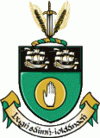County Louth (Louth)
 |
County Louth is named after the village of Louth, which in turn is named after Lugh, a god of the ancient Irish. Historically, the placename has had various spellings; Lugmad, Lughmhaigh, and Lughmhadh (see Historic Names List, for full listing). Lú is the modern simplified spelling.
The county is steeped in myth, legend and history, and is a setting in the Táin Bó Cúailnge epic. Later it saw the influence of the Vikings, as seen in the name of Carlingford Lough. They also established a longphort at Annagassan in the ninth century. At this time Louth consisted of three sub-kingdoms, each subject to separate over-kingdoms: Conaille (Ulaidh); Fir Rois (Airgialla); and, the Fir Arda Ciannachta (Midhe). The whole area became part of the O'Carroll Kingdom of Airgíalla (Oriel) early in the 12th century under Donnchad Ua Cerbaill. At the same time, the area was removed from the diocese of Armagh and the episcopal see of the Diocese of Airgíalla or Clogher was transferred to Louth c. 1130–1190.
A number of historic sites are in the county, including religious sites at Monasterboice, Mellifont Abbey and the St Mary Magdalene Dominican Friary.
The Normans occupied the Louth area in the 1180s, forming the County of Oriel (Uriel or Vriell) out of the O'Carroll kingdom. At this time the western boundary of occupation was unfixed and Monaghan was still considered part of Oriel. However, over time, Louth became differentiated as 'English' Oriel, to distinguish it from the remainder ('Irish' Oriel), outside the control of the Norman colony, which had passed into the hands of the McMahon lordship of Airgíalla.
In the early 14th century Edward Bruce made claim to the High Kingship of Ireland and led an expeditionary force to Ireland. The Scottish army was repulsed from Drogheda but laid waste to much of the Anglo-Norman colony of Ireland including Ardee and Dundalk. Edward was crowned on the hill of Maledon near Dundalk on 2 May 1316. His army was finally defeated and Edward was killed in the Battle of Faughart near Dundalk, by a chiefly local force led by John de Bermingham. He was created 1st Earl of Louth and granted estates at Ardee on 12 May 1319 as a reward for his services to the Crown in defeating the Scots. De Bermingham was subsequently killed in the Braganstown massacre on 13 June 1329 along with some 200 members of his family and household, in a feud between the Anglo-Irish families of Louth.
One of the Statutes of Kilkenny in 1465 (5 Ed. IV, cap. 3) stated "That every Irishman that dwell betwixt or amongst Englishmen in the County of Dublin, Myeth, Vriell [i.e. Oriel], and Kildare ... shall take to him an English surname of one town, as Sutton, Chester, Trym, Skryne, Corke, Kinsale; or colour, as white, blacke, browne; or arte or science, as smith or carpenter; or office, as cooke, butler ...". This was an attempt to compel Irish families in the Pale, including Louth, to adopt English surnames.
In 1189, a royal charter was granted to Dundalk after a Norman nobleman named Bertram de Verdun erected a manor house at Castletown Mount. Bertram's granddaughter Roesia de Verdun later built Castle Roche in 1236. In 1412, a royal charter was granted to Drogheda which unified the towns of Drogheda-in-Meath and Drogheda-in-Uriel (Louth) as a County in its own right, styled as ‘the County of the town of Drogheda’. Drogheda continued as a County Borough until the setting up of County Councils, through the enactment of the Local Government (Ireland) Act 1898, which saw all of Drogheda, including a large area south of the River Boyne, become part of an extended County Louth.
Until the late 16th century, 1596, Louth was considered part of Ulster, before becoming part of Leinster after a conference held at Faughart between the Chiefs of Ulster (Hugh O'Neill, Earl of Tyrone and Hugh Roe O'Donnell), on the Irish side, and the Ulster-born Miler Magrath, Anglican Archbishop of Cashel, and Thomas Butler, 10th Earl of Ormond on that of the English. The lands of Ballymascanlan, part of the former estates of Mellifont Abbey, were transferred from Armagh to Louth c. 1630.
The 16th and 17th centuries featured many skirmishes and battles involving Irish and English forces, as Louth was on the main route to 'the Moiry Pass' and the Ulster areas often in rebellion and as yet uncolonised. Oliver Cromwell attacked Drogheda in 1649 slaughtering the Royalist garrison and hundreds of the town's citizens. Towards the end of the same century, the armies of the warring Kings, James II and William (III) of Orange, faced off in south Louth during the build-up to the Battle of the Boyne; the battle was fought 3 km west from Drogheda. Drogheda held for James under Lord Iveagh but surrendered to William the day after the battle of the Boyne.
Map - County Louth (Louth)
Map
Country - Ireland
 |
 |
| Flag of the Republic of Ireland | |
Geopolitically, Ireland is divided between the Republic of Ireland (officially named Ireland), an independent state covering five-sixths of the island, and Northern Ireland, which is part of the United Kingdom. As of 2022, the population of the entire island is just over 7 million, with 5.1 million living in the Republic of Ireland and 1.9 million in Northern Ireland, ranking it the second-most populous island in Europe after Great Britain.
Currency / Language
| ISO | Currency | Symbol | Significant figures |
|---|---|---|---|
| EUR | Euro | € | 2 |
| ISO | Language |
|---|---|
| EN | English language |
| GA | Irish language |

















